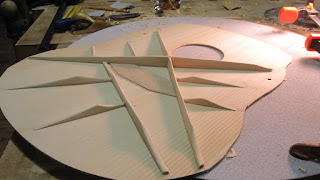
You might remember my guitar building motto: "If nothing else, it will have six strings and make a good drum." Well, I'm happy to report that I'm now officially halfway to that goal. No strings yet, since I have nothing to attach them to, but I have what I think is a very nice drum. It sounds great, and it's starting to look pretty good, too, if I do say so myself.
I have to admit it's a big moment in the process and it feels wonderful. But the best part is to move from cutting, carving and shaping chunks of wood to working with a guitar. It's an entirely different feeling and, without overstating it, it seems profound somehow.
Getting to this point over the past few weeks was filled with details, but an enjoyable process, nonetheless. After getting the top and back tuned just right, most of the rest of the time was spent fitting the top and back to the ribs. The top and back braces fit into notches in the kerfing, so making sure they all fit tightly is very important and requires a lot of patience. After fitting it all together, I clamped it to simulate gluing it and dropped a light inside to check for gaps - and there were many. So it took time to fit and shape and make corrections until it was ready to glue. The gluing process itself if as simple as can be. Once it's fit together, apply the glue and clamp it like crazy. That's all there is to it.
The last step I took this week was to cut away the excess top and back (they extend up to a couple of inches over the edge of the ribs) and to then sand it all down. I still have some detail sanding to finish next week, but then we'll begin the process of applying the binding around the edge of the guitar. The edge of the top will be routed and wood binding will be installed as both a construction and decorative feature. I chose walnut binding (as opposed to maple, rosewood, or ivoroid), so I hope it provides a nice contrast to the spruce top and rosewood sides. From what I understand, the binding process is time consuming and somewhat difficult, so I should be focused on that step for a while. After that, it's on to the neck!



